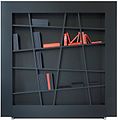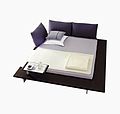Peter Maly
Peter Maly (born August 19, 1936 in Trautenau ) is a German interior and industrial designer . His field of activity is the design of furniture and furnishings.
Work biography
When he received orders from Ligne Roset in the 1980s , the French were expressly interested in his system experience and his understanding of technology. In fact, his work is still considered the epitome of German rationality. Maly, who was born in Bohemia, would hardly disagree. After training as a carpenter and studying interior design, he worked in the 1960s for the magazine Schöner Wohnen , which was just founded at the time , and is Germany's largest interior design journal , which he helped shape and which shaped him. With his monthly "sketchbook", in which he solved housing problems of the millions of readers, the newcomer became known in one fell swoop. In his photo staging of modern living spaces - a novelty at the time - he gained experience that became the basis of his career.
At the same time, the first furniture designs were created, first for Tecta and Interlübke , and later also for COR Sitzmöbel . With Axel Bruchhäuser, Leo Lübke sen. and Helmut Lübke , the young Maly met charismatic entrepreneurs here. At first it was the Danish furniture school and Pop Art that inspired him, but later he discovered the Bauhaus for himself. Since then, geometric shapes have been an integral part of the designs, such as the armchair cycle.
Self-employed from 1971, he worked as one of the first art directors in the industry, designing exhibition stands, catalogs and advertisements, and staging photos. First for Interlübke, which was the rule for almost all of its customers afterwards. This also explains the perfectionism that goes far beyond the actual design work. The man from Hamburg accompanied a product from start to finish, including the trade fair presentation and advertising campaign.
The breakthrough as a designer finally came in the mid-1980s, when the Maly bed (for Ligne Roset), the cycle armchair (for COR) and the Duo cabinet system (for Interlübke) were also commercially successful products from three major manufacturers almost simultaneously Market came. Even if Maly lets himself be guided by basic geometric shapes, he is always interested in function and practicality at the same time. "The chair is made for the bum, not for the head," he once put it in a plausible way. Longevity is also an important criterion. The chair 737 (1994 for Thonet ) combines a lot of these. "Furniture," says the ecologically inspired, "should be inheritable".
In the meantime, the old master of German furniture design has also left his clear signature in numerous other areas, be it lights (for Anta), pianos and grand pianos (for Sauter ), chimneys (for Conmoto ) or carpets (for Carpet Concept and JAB Anstoetz ). In doing so, Maly succeeded in transferring some of the last previously traditional professions to the modern age: This is what happened with the Pure piano and the Ambiente grand piano, or the Balance fireplace, the first modular fireplace.
Maly's trademarks remain seating furniture such as the legendary cycle armchair and the Circo armchair group (both for COR) and cupboard systems, including epoch-making programs such as Menos (for Behr) or Quadrat (for Kröncke), which has not aged for a quarter of a century, and the Maly bed ( for Ligne Roset), in production from 1984 to 2012. Such successes are based not least on his ability to get involved with the different corporate cultures. This is also demonstrated by the collaboration with the Japanese furniture manufacturer Conde House, a task in which Japanese aesthetics and European design culture had to be combined. The design of every product requires an intensive process, because: "Design needs communication".
(Bernd Polster)
Works
Quotes
“Making products fashionable, subjecting them to a rhythm that is far too fast is downright irresponsible! The aim of my work is to create forms that can last for a long time. "
“I love working with clear, geometric shapes. This logically justifiable formal language saved me from getting lost in irrationalities. "
"Maybe we designers are equipped with the necessary artistic sensitivity to sense demands from people that do not even exist in their heads."
“Anyone who actually claims that perfect function and good design represent opposing poles, the opposite is the case! Good design is only created by combining the two! "
"Right at the beginning of the design process, I deal with the question of how the new piece of furniture can connect with the future space and the other components."
Prizes and awards
- Federal Prize for Good Form
- Homage de l'industrie aux créateurs Paris
- Homage to the Salon du meuble de Paris
- iF design award (8 ×)
- red dot design award (12 ×)
- Design Prize Switzerland (2 ×)
- Exhibition Design Award , imm cologne (2 × silver, 1 × gold),
- International Design Award Baden-Württemberg
- State award hamburgund design (2 ×)
- Good Design Award Chicago (19 ×)
- Interior Innovation Award Cologne (2 ×)
- Furniture of the year award from the Schöner Wohnen editorial team
- Grand Prix Brno
- iF communication design award
- Nomination for the design award of the Federal Republic of Germany
Exhibitions
- 2001 Exhibition at the Museum for Art and Commerce in Hamburg.
- 2002 Exhibition at the Kunstgewerbemuseum Berlin .
- 2002 Exhibition in the Red Dot Design Museum Essen.
- 2004 Exhibition "sketched design" in the Museum for Art and Industry Hamburg.
- 2011 Exhibition "Design from four decades" in the Wenzel-Hablik-Museum in Itzehoe.
- 2016/2017: Exhibition Peter Maly - Works from Four Decades , Designxport , Hamburg.
literature
- Axel Buck, Matthias Vogt (ed.): Peter Maly. Designer monographs. Verlag Form, Frankfurt am Main 1998, ISBN 3-931317-91-9 .
- Bernd Polster (Ed.): Work biography design Peter Maly. DuMont, Cologne 2007, ISBN 978-3-8321-7771-3 .
- Bernd Polster among others: Furniture design Germany. The classics. DuMont Literature and Art, Cologne 2005, ISBN 3-8321-7365-X , p. 326.
- Modern classics, furniture that makes history. Gruner + Jahr, Hamburg 1980, ISBN 3-570-01367-7 , p. 204.
- The Designer's Book. Callwey, Munich 2011, ISBN 978-3-7667-1930-0 , p. 132.
- Peter Zec (Ed.): Who's Who in Design. reddot edition, Essen 2007, ISBN 978-3-89939-083-4 , pp. 360-361.
- Bernd Polster (Ed.): Home design Germany. the classics. DuMont, Cologne 2008, ISBN 978-3-8321-7767-6 , p. 493.
- Design Lexicon Germany. Dumont, Cologne 2000, ISBN 3-7701-4429-5 , pp. 236-237.
- The book of classics. Südwest-Verlag, Munich 2011, ISBN 978-3-517-08706-1 , pp. 97 + 140 + 189 + 196.
Web links
| personal data | |
|---|---|
| SURNAME | Maly, Peter |
| BRIEF DESCRIPTION | German interior architect and industrial designer |
| DATE OF BIRTH | August 19, 1936 |
| PLACE OF BIRTH | Trautenau |






